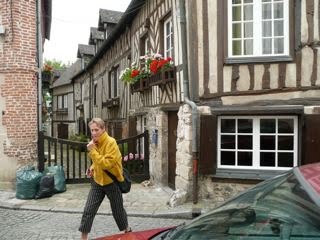The history of the Louvre is long and rich with characters from the pages of French textbooks. Words like enormous, monstrous, gigantic, etc., just don't seem to adequately describe its size, importance, or character. Luckily, it has survived the test of time to give all who visit a genuine sense of its place as a world monument. One enters through the famous pyramid, designed by I.M. Peï and opened in 1989, then quickly descends into a grand welcome center directly under the pyramid. This is the heart of an underground complex that spiders out into the various museum galleries, conference rooms, auditoriums, snack bars, restaurants, a bookshop, as well as into an upscale shopping center that connects directly with Line 1 of the Paris subway. After entering the through the pyramid, the eyes are drawn automatically back up to the glass ceiling where surrounding building facades oversee the museum's daily visitations. At dusk, this vision is truly magical when the entry hall is darker than the twilight sky above. Outside surrounding the pyramid are several triangular shaped reflecting pools that are about knee-high and aren't even visible until close approach. In the day-light these add radiance to the entrance and in the evening they provide dancing displays from nearby light sources. There are 3 smaller pyramids positioned at points where the walkways join, providing a window to the outside from below. The Louvre's website is excellent where one can discover lots about the place without ever going. http://www.louvre.fr/llv/commun/home.jsp
The Louvre hosts many cultural events besides art exhibits. In the past month, we have been there a couple of times to concerts in an auditorium that is acoustically wonderful and small enough that every seat is a good one. Wednesday night we heard a choral concert of baroque music that was stunning, with some 12 singers and about the same number of musicians. The concert started at 8pm, it was raining outside and chilly when I left the apartment. I took the bus and got off just across from the Louvre. The arched entrance into one of the Louvre's interior courtyards that I would normally take was blocked due to construction so I had to walk around to another entrance. As I acrossed the uneven, wet stones of the courtyard I looked up at the four surrounding walls and had the distinct feeling of what it must have been like walking that same path in the 17th or 18th century. That courtyard connects to the Cour Napoléon, where the pyramid is, through an archway the length of that building's wing. It was dark but bustling with people and off to the side a cellist played a classical piece of music for public enjoyment. It was a sensual moment and I felt truly blessed to be living in such an artistically rich part of the world.

No comments:
Post a Comment